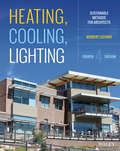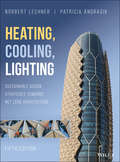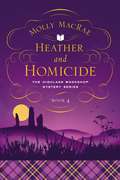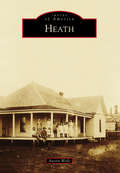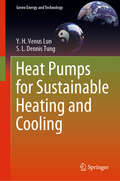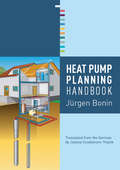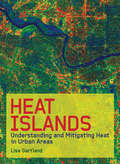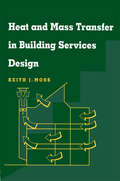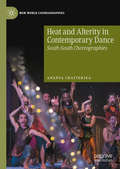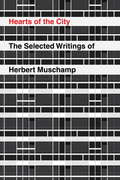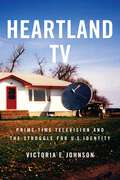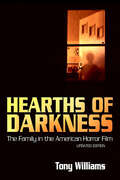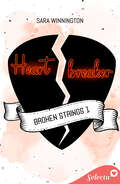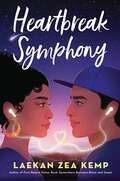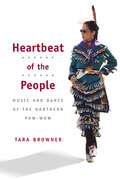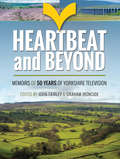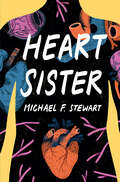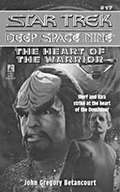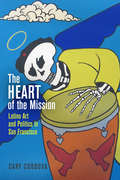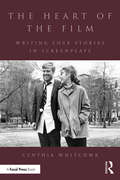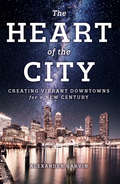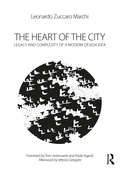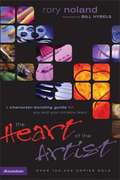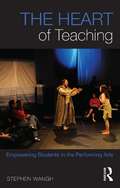- Table View
- List View
Heating, Cooling, Lighting
by Norbert LechnerSustainable environmental control through building designHeating, Cooling, and Lighting is the industry standard text on environmental control systems with the emphasis on sustainable design. By detailing the many factors that contribute to the comfort in a building, this book helps architects minimize mechanical systems and energy usage over the life of the building by siting, building design, and landscaping to maximize natural heating, cooling, and lighting. This new fourth edition includes new information on integrated design strategies and designing for the Tropics. Resources include helpful case studies, checklists, diagrams, and a companion website featuring additional cases, an image bank, and instructor materials.Designing buildings that require less energy to heat, cool, and light means allowing the natural energy of the sun and wind to reduce the burden on the mechanical and electrical systems. Basic design decisions regarding size, orientation, and form have a great impact on the sustainability, cost, and comfort of a building. Heating, Cooling, and Lighting provides detailed guidance for each phase of a design project. Readers will:Understand the concept of sustainability as applied to energy sourcesReview the basic principles of thermal comfort, and the critical role of climateLearn the fundamentals of solar responsive design, including active and passive solar systems as well as photovoltaicsDiscover how siting, architectural design, and landscaping can reduce the requirements for mechanical and electrical systemsIn sustainable design, mechanical, and electrical systems should be used to only accomplish what the architect could not by the design of the building itself. With this in mind, designers require a comprehensive understanding of both the properties of energy and the human factors involved in thermal comfort. Heating, Cooling, and Lighting is the complete, industry-leading resource for designers interested in sustainable environmental control.
Heating, Cooling, Lighting: Sustainable Design Strategies Towards Net Zero Architecture (Coursesmart Ser.)
by Norbert M. Lechner Patricia AndrasikThe essential guide to environmental control systems in building design For over 25 years Heating, Cooling, Lighting: Sustainable Design Strategies Towards Net Zero Architecture has provided architects and design professionals the knowledge and tools required to design a sustainable built environment at the schematic design stage. This Fifth Edition offers cutting-edge research in the field of sustainable architecture and design and has been completely restructured based on net zero design strategies. Reflecting the latest developments in codes, standards, and rating systems for energy efficiency, Heating, Cooling, Lighting: Sustainable Design Strategies Towards Net Zero Architecture includes three new chapters: Retrofits: Best practices for efficient energy optimization in existing buildings Integrated Design: Strategies for synergizing passive and active design Design Tools: How to utilize the best tools to benchmark a building's sustainability and net zero potential Heating, Cooling, Lighting: Sustainable Design Strategies Towards Net Zero Architecture is a go-to resource for practicing professionals and students in the fields of environmental systems technology or design, environmental design systems, construction technology, and sustainability technology.
Heather and Homicide: The Highland Bookshop Mystery Series: Book 4
by Molly MacRaeThe new novel in the acclaimed Highland Bookshop mystery series finds a true-crime author murdered in the charming seacoast town of Inversgail—can the women of Yon Bonnie Books discover the killer&’s identity before he or she strikes again?True crime writer Heather Kilbride arrives in the seacoast town of Inversgail, Scotland, to research a recent murder for her new book. But if that&’s true, why does she seem more interested in William Clark, a shadowy lawyer with no connection to the murder? Her nosy questions arouse the suspicions of Constable Hobbs, the members of a local writers&’ group, and Janet Marsh and her crew of amateur sleuths at Yon Bonnie Books. Heather&’s unconventional research methods prove deadly when Janet discovers her lifeless body. Except the &“body&” turns out to be a dummy dressed-up to look like Heather. Meanwhile, Heather is sitting at a safe distance observing Janet&’s reactions. Then Heather is found dead—again—sprawled at the base of an ancient standing stone; and this time it&’s for real. Clutched in her hand is a valuable miniature book last seen at Yon Bonnie Books, and now the police want to know how Heather, the miniature book, and Janet are all connected. But Janet and her group of sleuths have two questions of their own: Who else is interested in knowing that connection—and is that person a cold-blooded killer?
Heath (Images of America)
by Austin WellsWhen John O. Heath first settled in the area now known as Heath in 1848, wild turkey and deer were as plentiful as the area's timber and rich, black soil. The fertile land and convenient location along the east fork of the Trinity River prompted several settlers to follow the Heath family's lead, and Heath experienced steady growth in the early 1900s, with several businesses and schools in operation. Life was hard in those days, with food and money hard to come by, but locals found sanctuary in social gatherings, endless games of 42, mink hunting in the winter, and baseball. Heath's economy was given a big lift when the lake adjacent to the community, known as Lake Ray Hubbard, was filled in 1969 after a seemingly endless rain. With the attraction of the lake and developments that stemmed from it, such as the Rush Creek Yacht Club, Heath now faces the challenge of maintaining steady growth while continuing to stick to its roots as a charming, tight-knit community with an open countryside atmosphere.
Heat Pumps for Sustainable Heating and Cooling (Green Energy and Technology)
by Y. H. Lun S. L. TungThis book highlights the significance of using sustainable energy to prevent the deterioration of our planet using heat pumps. Energy sustainability can be achieved through improved energy efficiency. In this regard, heat pumps offer an energy-efficient alternative for heating and cooling. To drive the adoption of heat pumps as a key component of sustainable buildings, the authors focus on examining sustainable practices in heat pump operations and innovative system design. In view of the growing desire to use sustainable energy to meet heating and cooling demands and improve indoor air quality, this book offers a valuable reference guide to the available options in HVAC (heating, ventilation, and air-conditioning) system design. To begin with, the authors define sustainable energy and discuss the trend of “thinking green” in building design. They then discuss sustainable practices and heat pump applications in mapping out HVAC systems. In turn, they examine the use of green operations to promote sustainable practices and, in order to highlight the importance of innovative design, discuss the configuration options and precision control aspects. In closing, the authors illustrate innovative sustainable design on the basis of several energy-efficient cases. The book’s main goal is to drive the adoption of sustainable energy solutions. Heat pumps, it argues, represent the most efficient system for meeting commercial/recreational/residential heating and cooling demands. The book not only examines industrial practices in heat pump application, but also discusses advanced heat pump technologies and innovative heat pump designs.
Heat Pump Planning Handbook
by Jürgen BoninThe Heat Pump Planning Handbook contains practical information and guidance on the design, planning and selection of heat pump systems, allowing engineers, designers, architects and construction specialists to compare a number of different systems and options. Including detailed descriptions of components and their functions and reflecting the current state of technology this guide contains sample tasks and solutions as well as new model calculations and planning evaluations. Also economic factors and alternative energy sources are covered, which are essential at a time of rising heat costs. Topics included: Ecological and economic aspects Introduction to Refrigeration Water heat pump systems Configuration of all necessary components Planning Examples (Problems and Solutions)
Heat Pump Controls to Exploit the Energy Flexibility of Building Thermal Loads (Springer Theses)
by Thibault PéanThis book describes different control strategies adapted to heat pumps, at the purpose of increasing energy flexibility in buildings. It reports on the development of both simple rule-based controls (RBC) and advanced model predictive controls (MPC). These are tested and compared in both simulation and experimental setups. The book analyzes in detail all the different steps, including the development and tuning of the controllers, their testing in experimental settings and simulation studies. Bridging between advanced control systems theory concepts and practical needs, and discussing the advantages and main challenges of MPC and RBC controllers in terms of efficiency of heat pump operation, electricity prices, emission values, and users’ comfort, this book offers an in-depth evaluation of innovative control strategies applied to energy demand management in buildings.
Heat Islands: Understanding and Mitigating Heat in Urban Areas
by Lisa Mummery GartlandHeat islands are urban and suburban areas that are significantly warmer than their surroundings. Traditional, highly absorptive construction materials and a lack of effective landscaping are their main causes. Heat island problems, in terms of increased energy consumption, reduced air quality and effects on human health and mortality, are becoming more pressing as cities continue to grow and sprawl. This comprehensive book brings together the latest information about heat islands and their mitigation. The book describes how heat islands are formed, what problems they cause, which technologies mitigate heat island effects and what policies and actions can be taken to cool communities. Internationally renowned expert Lisa Gartland offers a comprehensive source of information for turning heat islands into cool communities. The author includes sections on cool roofing and cool paving, explains their benefits in detail and provides practical guidelines for their selection and installation. The book also reviews how and why to incorporate trees and vegetation around buildings, in parking lots and on green roofs.
Heat and Mass Transfer in Building Services Design
by Keith MossBuilding design is increasingly geared towards low energy consumption. Understanding the fundamentals of heat transfer and the behaviour of air and water movements is more important than ever before. Heat and Mass Transfer in Building Services Design provides an essential underpinning knowledge for the technology subjects of space heating, water services, ventilation and air conditioning. This new text: *provides core understanding of heat transfer and fluid flow from a building services perspective *complements a range of courses in building services engineering *underpins and extends the themes of the author's previous books: Heating and Water Services Design in Buildings; Energy Management and Operational Costs in Buildings Heat and Mass Transfer in Building Services Design combines theory with practical application for building services professional and students. It will also be beneficial to technicians and undergraduate students on courses in construction and mechanical engineering.
Heat and Alterity in Contemporary Dance: South-South Choreographies (New World Choreographies)
by Ananya ChatterjeaThis book argues that contemporary dance, imagined to have a global belonging, is vitiated by euro-white constructions of risk and currency that remain at its core. Differently, the book reimagines contemporary dance along a “South-South” axis, as a poly-centric, justice-oriented, aesthetic-temporal category, with intersectional understandings of difference as a central organizing principle. Placing alterity and heat, generated via multiple pathways, at its center, it foregrounds the work of South-South artists, who push against constructions of “tradition” and white-centered aesthetic imperatives, to reinvent their choreographic toolkit and respond to urgent questions of their times. In recasting the grounds for a different “global stage,” the argument widens its scope to indicate how dance-making both indexes current contextual inequities and broader relations of social, economic, political, and cultural power, and inaugurates future dimensions of justice.
Hearts of the City
by Nicolai Ouroussoff Herbert MuschampFrom the late Herbert Muschamp, the former architecture critic of The New York Times and one of the most outspoken and influential voices in architectural criticism, a collection of his best work.The pieces here--from The New Republic, Artforum, and The New York Times--reveal how Muschamp's views were both ahead of their time and timeless. He often wrote about how the right architecture could be inspiring and uplifting, and he uniquely drew on film, literature, and popular culture to write pieces that were passionate and often personal, changing the landscape of architectural criticism in the process. These columns made architecture a subject accessible to everyone at a moment when, because of the heated debate between modernists and postmodernists, architecture had become part of a larger public dialogue. One of the most courageous and engaged voices in his field, he devoted many columns at the Times to the lack of serious new architecture in this country, and particularly in New York, and spoke out against the agenda of developers. He departed from the usual dry, didactic style of much architectural writing to playfully, for example, compare Frank Gehry's Guggenheim Bilbao to the body of Marilyn Monroe or to wax poetic about a new design for Manhattan's manhole covers. One sees in this collection that Muschamp championed early on the work of Frank Gehry, Rem Koolhaas, Zaha Hadid, Thom Payne, Frank Israel, Jean Nouvel, and Santiago Calatrava, among others, and was drawn to the theoretical writings of such architects as Peter Eisenman. Published here for the first time is the uncut version of his brilliant and poignant essay about gay culture and Edward Durrell Stone's museum at 2 Columbus Circle. Fragments from the book he left unfinished, whose title we took for this collection--"A Dozen Years," "Metroscope," and "Atomic Secrets"--are also included. Hearts of the City is dazzling writing from a humanistic thinker whose work changed forever the way we think about our cities--and the buildings in them.
Heartland TV: Prime Time Television and the Struggle for U.S. Identity
by Victoria E. JohnsonWinner of the 2009 Society for Cinema and Media Studies Katherine Singer Kovacs Book AwardThe Midwest of popular imagination is a "Heartland" characterized by traditional cultural values and mass market dispositions. Whether cast positively --; as authentic, pastoral, populist, hardworking, and all-American--or negatively--as backward, narrow-minded, unsophisticated, conservative, and out-of-touch--the myth of the Heartland endures.Heartland TV examines the centrality of this myth to television's promotion and development, programming and marketing appeals, and public debates over the medium's and its audience's cultural worth. Victoria E. Johnson investigates how the "square" image of the heartland has been ritually recuperated on prime time television, from The Lawrence Welk Show in the 1950s, to documentary specials in the 1960s, to The Mary Tyler Moore Show in the 1970s, to Ellen in the 1990s. She also examines news specials on the Oklahoma City bombing to reveal how that city has been inscribed as the epitome of a timeless, pastoral heartland, and concludes with an analysis of network branding practices and appeals to an imagined "red state" audience.Johnson argues that non-white, queer, and urban culture is consistently erased from depictions of the Midwest in order to reinforce its "reassuring" image as white and straight. Through analyses of policy, industry discourse, and case studies of specific shows, Heartland TV exposes the cultural function of the Midwest as a site of national transference and disavowal with regard to race, sexuality, and citizenship ideals.
Hearths of Darkness: The Family in the American Horror Film, Updated Edition
by Tony WilliamsHearths of Darkness: The Family in the American Horror Film traces the origins of the 1970s family horror subgenre to certain aspects of American culture and classical Hollywood cinema. Far from being an ephemeral and short-lived genre, horror actually relates to many facets of American history from its beginnings to the present day. Individual chapters examine aspects of the genre, its roots in the Universal horror films of the 1930s, the Val Lewton RKO unit of the 1940s, and the crucial role of Alfred Hitchcock as the father of the modern American horror film. Subsequent chapters investigate the key works of the 1970s by directors such as Larry Cohen, George A. Romero, Brian De Palma, Wes Craven, and Tobe Hooper, revealing the distinctive nature of films such as Bone, It's Alive, God Told Me To, Carrie, The Exorcist, Exorcist 2, The Texas Chainsaw Massacre, as well as the contributions of such writers as Stephen King. Williams also studies the slasher films of the 1980s and 1990s, such as the Friday the 13th series, Halloween, the remake of The Texas Chainsaw Massacre, and Nightmare on Elm Street, exploring their failure to improve on the radical achievements of the films of the 1970s.After covering some post-1970s films, such as The Shining, the book concludes with a new postscript examining neglected films of the twentieth and early twenty-first century. Despite the overall decline in the American horror film, Williams determines that, far from being dead, the family horror film is still with us. Elements of family horror even appear in modern television series such as The Sopranos. This updated edition also includes a new introduction.
Heartbreaker (Broken Strings #Volumen 1)
by Sara Winnington¿Qué ocurre cuando el amor y el odio colisionan? Descubre la fuerza de la música y la pasión en la serie Broken Strings. Cuando Alyssa Jones entra en el Concorde como candidata para ser la nueva cantante de Broken Strings, sabe que las cosas van a cambiar en su vida. Y de qué manera. Allí la esperan los ojos cautivadores del guitarrista, Paul Rush, el rompecorazones de la banda, que gracias a la música tiene un ligue nuevo a la semana. La rutina de seductor de Paul da un vuelco al conocer a la nueva vocalista, Alyssa: tanto ella como su sonrisa son su talón de Aquiles. Y, si quiere conquistarla, tendrá que dejar a un lado algunos de los rasgos más... «encantadores» de su personalidad. Por su bien, el del grupo y por el del Concorde. Porque la vida es muy complicada, y hay más fuerzas que se mueven en contra de los Broken Strings, tratando de cerrarles la sala de conciertos y lugarde ensayos. Y Alyssa y Paul tendrán que trabajar juntos para intentar evitarlo. Dos vidas diferentes. Dos personas unidas por la música. Un mismo objetivo.
Heartbreak Symphony
by Laekan Zea KempClap When You Land meets On the Come Up in this heart-gripping story about navigating first love and overcoming grief through the power of music. Aarón Medrano has been haunted by the onstage persona of his favorite DJ ever since his mother passed away. He seems to know all of Aarón&’s deepest fears, like how his brain doesn&’t work the way it should and that&’s why his brother and father seem to be pushing him away. He thinks his ticket out is a scholarship to the prestigious Acadia School of Music. That is, if he can avoid blowing his audition.Mia Villanueva has a haunting of her own and it&’s the only family heirloom her parents left her: doubt. It&’s the reason she can&’t overcome her stage fright or believe that her music is worth making. Even though her trumpet teacher tells her she has a gift, she&’s not sure if she&’ll ever figure out how to use it or if she&’s even deserving of it in the first place. When Aarón and Mia cross paths, Aarón sees a chance to get close to the girl he&’s had a crush on for years and to finally feel connected to someone since losing his mother. Mia sees a chance to hold herself accountable by making them both face their fears, and hopefully make their dreams come true. But soon they&’ll realize there&’s something much scarier than getting up on stage—falling in love with a broken heart.
Heartbeat of the People: Music and Dance of the Northern Pow-wow (Music in American Life)
by Tara BrownerThe intertribal pow-wow is the most widespread venue for traditional Indian music and dance in North America. Heartbeat of the People is an insider's journey into the dances and music, the traditions and regalia, and the functions and significance of these vital cultural events. Tara Browner focuses on the Northern pow-wow of the northern Great Plains and Great Lakes to investigate the underlying tribal and regional frameworks that reinforce personal tribal affiliations. Interviews with dancers and her own participation in pow-wow events and community provide fascinating on-the-ground accounts and provide detail to a rare ethnomusicological analysis of Northern music and dance.
Heartbeat and Beyond: Memoirs of 50 Years of Yorkshire Television
by John Fairley Graham IronsideIn 1968 a group of young people took over a derelict trouser factory in a rundown part of Leeds and set about producing programmes that were to define the British television world of the late 20th Century.These included the investigative documentary series First Tuesday, Darling Buds of May, Whickers World, Dont Ask Me and Heartbeat.At the same time they attracted, indeed often created, stars of international fame such as James Mason, Catherine Zeta Jones, Alan Whicker, David Jason, Magnus Pike and David Frost.Fifty years on, their achievements and experiences, often dramatic and frequently absurd, make for fascinating behind-the-scenes reading. This book paints a colourful and entertaining picture of the making from virtually nothing of one of the greatest television channels of all times.
Heart Sister
by Michael F. StewartAfter his twin sister, Minnie, dies in an accident, Emmitt's world goes sideways. He’s lost his best friend and it feels like the family is falling apart without her. But Minnie was an organ donor and Emmitt soon receives an anonymous thank you letter from one of the transplant recipients. Inspiration strikes, and he decides to try and put his sister back together, in spirit. He’s going to track down each organ recipient and film them to show his parents the results of Minnie’s selfless act and help them move on. But when each recipient falls short of his expectations and the star of his film, the girl who received his sister’s heart, refuses to meet him, Emmitt has to turn to extreme measures to find her. What he doesn’t know is that his "heart sister" is hiding an agonizing secret, one that could push Emmitt to the breaking point.Orca Book Publishers is proud to offer this early ebook edition as part of our new Digital First initiative, with the release of the print edition to follow.
The Heart Of The Warrior (Star Trek )
by John Gregory BetancourtWhile a crucial peace conference fills Deep Space NineTMwith rumors of intrigue and conspiracy, Major Kira and Lt. Commander Worf embark on a dangerous undercover mission deep into the heart of the Gamma Quadrant. Their mission: to find the secret of the addictive substance that the Changelings use to control their Jem'Hadar warriors. But how long can Worf and Kira remain undetected in the midst of the Dominion? Odo may be their only hope; but to save them, he'll have to stand against his own people.
The Heart of the Mission: Latino Art and Politics in San Francisco
by Cary CordovaIn The Heart of the Mission, Cary Cordova combines urban, political, and art history to examine how the Mission District, a longtime bohemian enclave in San Francisco, has served as an important place for an influential and largely ignored Latino arts movement from the 1960s to the present. Well before the anointment of the "Mission School" by art-world arbiters at the dawn of the twenty-first century, Latino artists, writers, poets, playwrights, performers, and filmmakers made the Mission their home and their muse.The Mission, home to Chileans, Cubans, Guatemalans, Mexican Americans, Nicaraguans, Puerto Ricans, and Salvadorans never represented a single Latino identity. In tracing the experiences of a diverse group of Latino artists from the 1940s to the turn of the century, Cordova connects wide-ranging aesthetics to a variety of social movements and activist interventions. The book begins with the history of the Latin Quarter in the 1940s and the subsequent cultivation of the Beat counterculture in the 1950s, demonstrating how these decades laid the groundwork for the artistic and political renaissance that followed. Using oral histories, visual culture, and archival research, she analyzes the Latin jazz scene of the 1940s, Latino involvement in the avant-garde of the 1950s, the Chicano movement and Third World movements of the 1960s, the community mural movement of the 1970s, the transnational liberation movements in Nicaragua and El Salvador, and the AIDS activism of the 1980s. Through these different historical frames, Cordova links the creation of Latino art with a flowering of Latino politics.
The Heart of the Film: Writing Love Stories in Screenplays
by Cynthia WhitcombMost movies include a love story, whether it is the central story or a subplot, and knowing how to write a believable relationship is essential to any writer's skill set. Discover the rules and laws of nature at play in a compelling love story and learn and master them. Broken into four sections, The Heart of the Film identifies the critical features of love story development, and explores every variation of this structure as well as a diverse array of relationships and types of love. Author Cynthia Whitcomb has sold over 70 feature-length screenplays and shares the keys to her success in The Heart of the Film, drawing on classic and modern films as well as her own extensive experience.
The Heart of the City: Creating Vibrant Downtowns for a New Century
by Alexander GarvinDowntowns are more than economic engines: they are repositories of knowledge and culture and generators of new ideas, technology, and ventures. They are the heart of the city that drives its future. If we are to have healthy downtowns, we need to understand what downtown is all about; how and why some American downtowns never stopped thriving (such as San Jose and Houston), some have been in decline for half a century (including Detroit and St. Louis), and still others are resurging after temporary decline (many, including Lower Manhattan and Los Angeles). The downtowns that are prospering are those that more easily adapt to changing needs and lifestyles.In The Heart of the City, distinguished urban planner Alexander Garvin shares lessons on how to plan for a mix of housing, businesses, and attractions; enhance the public realm; improve mobility; and successfully manage downtown services. Garvin opens the book with diagnoses of downtowns across the United States, including the people, businesses, institutions, and public agencies implementing changes. In a review of prescriptions and treatments for any downtown, Garvin shares brief accounts—of both successes and failures—of what individuals with very different objectives have done to change their downtowns. The final chapters look at what is possible for downtowns in the future, closing with suggested national, state, and local legislation to create standard downtown business improvement districts to better manage downtowns.This book will help public officials, civic organizations, downtown business property owners, and people who care about cities learn from successful recent actions in downtowns across the country, and expand opportunities facing their downtown. Garvin provides recommendations for continuing actions to help any downtown thrive, ensuring a prosperous and thrilling future for the 21st-century American city.
The Heart of the City: Legacy and Complexity of a Modern Design Idea
by Leonardo Zuccaro MarchiThe Heart of the City concept, which was introduced at CIAM 8 in 1951, has played an important role in architectural and urban debates. The Heart became the most important of the organic references used in the 1950s for defining a theory of urban form. This book focuses on both the historical and theoretical reinterpretation of this seminal concept. Divided into two main sections, both looking at differing ways in which the Heart has influenced more recent urban thinking, it illustrates the continuity and the complexities of the Heart of the City. In doing so, this book offers a new perspective on the significance of public space and shows how The Heart of the City still resonates closely with contemporary debates about centrality, identity and the design of public space. It would be of interest to architects, academics and students of urban design and planning.
The Heart of the Artist: A Character-Building Guide for You and Your Ministry Team
by Rory NolandTalks about people with an artistic temperament and the struggles that they can have as they try and serve God and how they can use their gifts effectively with discipline.
The Heart of Teaching: Empowering Students in the Performing Arts
by Stephen WanghThe Heart of Teaching is a book about teaching and learning in the performing arts. Its focus is on the inner dynamics of teaching: the processes by which teachers can promote—or undermine—creativity itself. It covers the many issues that teachers, directors and choreographers experience, from the frustrations of dealing with silent students and helping young artists ‘unlearn’ their inhibitions, to problems of resistance, judgment and race in the classroom,. Wangh raises questions about what can—and what cannot—be taught, and opens a discussion about the social, psychological and spiritual values that underlie the skills and techniques that teachers impart. Subjects addressed include: Question asking: which kinds of questions encourage creativity and which can subvert the learning process. Feedback: how it can foster both dependence and independence in students. Grading: its meaning and meaninglessness. Power relationships, transference and counter-transference The pivotal role of listening. The Heart of Teaching speaks to experienced teachers and beginning teachers in all disciplines, but is particularly relevant to those in the performing arts, from which most of its examples are drawn. It brings essential insight and honesty to the discussion of how to teach.
